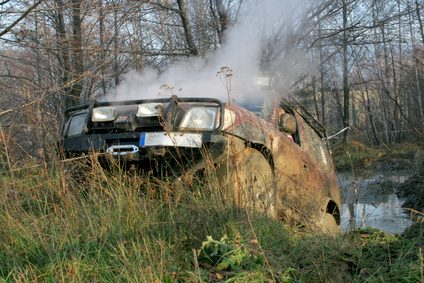
Tire size has no effect on gear ratio; the gear ratio itself is a fixed mechanical constant determined by the number of teeth on the axles input (pinion) gear and output (ring) gear. However, tire size can, and does, affect the vehicle's "effective" gear ratio, which is a somewhat more complicated matter.
Effective ratio is all about how much ground the tire covers per revolution (a.k.a. "circumference"), which has everything to do with its diameter. Tire circumference is easy to calculate using that old grade-school formula "2 x Pi (3.14) x R (radius)." We'll use a 30-inch-tall (30-inch diameter) tire as an example. Two multiplied by 3.14 equals 6.28; since radius is equal to half of diameter, we'll next multiply 15 (30 divided by 2) by 6.28 to get 94.2 inches in circumference. You can actually just use the shortcut "Diameter x 3.14" in this particular instance, since you're multiplying by two and then dividing by it.
As in the above example, say you're switching from a 30-inch-tall tire to a 40-inch tire. The 40-inch tire covers 125.5 inches per revolution, which is 31.4 more than the 30-inch. Divide 31.4 by the original tire's circumference and you arrive at 0.333, which, when converted to percentage, comes out to 33.3 percent. That's the effective drop in gear ratio you'll experience when switching to the larger tire. The equation looks like this: "N" (circumference of new tire) minus "O" (circumference of old tire) equals "D" (difference). "D" divided by "O" equals the change in percentage.
Effective ratio is vitally important since it's directly relative to your vehicle's torque output and acceleration. To get the effective ratio, multiply the percentage in change by the original gear ratio and then subtract from the axle ratio. We'll say 0.333 times a stock axle ratio of 4:1 (1.333), which nets you a new ratio of 2.7:1.
If you're running larger tire and want to return your vehicle to its stock effective gear ratio and acceleration, you'll need to change out the gearset in the differential. To find out what your new ideal gear ratio will be, simply add the percentage in change from the old ratio (1.333 in our example) to your existing ratio. In this example, that leaves you looking for a new gearset with a 5.333:1 ratio.
Not all changes in performance due to tire diameter are necessarily bad. changing tires is a good way to make minor changes to your vehicle's acceleration and top speed without having to resort to a gearing change in the differential. For instance, if you're drag racing and your engine hits its red-line before you hit the end of the drag-strip, you can install larger tires to lower the effective gear ratio. The opposite also holds true. If, at the end of the drag strip, your tachometer reads 1,000 RPM below the engine's peak power RPM then you can see some serious gains in acceleration by simply switching to a smaller tire.